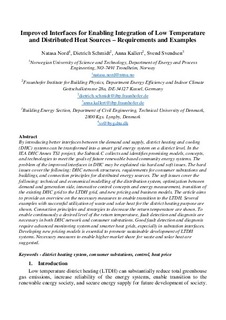| dc.description.abstract | By introducing better interfaces between the demand and supply, district heating and cooling (DHC) systems can be transformed into a smart grid energy system on a district level. In the IEA DHC Annex TS1 project, the Subtask C collects and identifies promising models, concepts, and technologies to meet the goals of future renewable based community energy systems. The problem of the improved interfaces in DHC may be explained via hard and soft issues. The hard issues cover the following: DHC network structures, requirements for consumer substations and buildings, and connection principles for distributed energy sources. The soft issues cover the following: technical and economical modelling of the distribution system, optimization between demand and generation side, innovative control concepts and energy measurement, transition of the existing DHC grid to the LTDH grid, and new pricing and business models. The article aims to provide an overview on the necessary measures to enable transition to the LTDH. Several examples with successful utilization of waste and solar heat for the district heating purpose are shown. Connection principles and strategies to decrease the return temperature are shown. To enable continuously a desired level of the return temperature, fault detection and diagnosis are necessary in both DHC network and consumer substations. Good fault detection and diagnosis require advanced monitoring system and smarter heat grids, especially in substation interfaces. Developing new pricing models is essential to promote sustainable development of LTDH systems. Necessary measures to enable higher market share for waste and solar heat are suggested. | nb_NO |
